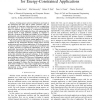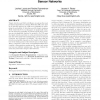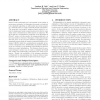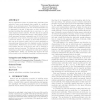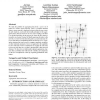IPSN
2007
Springer
14 years 5 months ago
2007
Springer
— Existing sensor network architectures are based on the assumption that data will be polled. Therefore, they are not adequate for long-term battery-powered use in applications t...
IPSN
2007
Springer
14 years 5 months ago
2007
Springer
IPSN
2007
Springer
14 years 5 months ago
2007
Springer
The development of high-level programming environments is essential if wireless sensor networks are to be accessible to nonexperts. In this paper, we present the Regiment system, ...
IPSN
2007
Springer
14 years 5 months ago
2007
Springer
IPSN
2007
Springer
14 years 5 months ago
2007
Springer
Target detection and field surveillance are among the most prominent applications of Sensor Networks (SN). The quality of detection achieved by a SN can be quantified by evaluat...
IPSN
2007
Springer
14 years 5 months ago
2007
Springer
Sensor location information is a prerequisite to the utility of most sensor networks. In this paper we present a robust and low-complexity algorithm to self-localize and orient se...
IPSN
2007
Springer
14 years 5 months ago
2007
Springer
Many sensor nodes contain resource constrained microcontrollers where user level applications, operating system components, and device drivers share a single address space with no...
IPSN
2007
Springer
14 years 5 months ago
2007
Springer
Multimodal applications require the acquisition and processing of massive amounts of information from multiple sensors. Because this process is beyond the capabilities of a single...
IPSN
2007
Springer
14 years 5 months ago
2007
Springer
The key application scenario of wireless sensor networks is data gathering: sensor nodes transmit data, possibly in a multi-hop fashion, to an information sink. The performance of...
IPSN
2007
Springer
14 years 5 months ago
2007
Springer
We study the problem of aggregating data from a sparse set of nodes in a wireless sensor network. This is a common situation when a sensor network is deployed to detect relatively...
